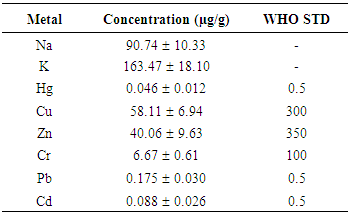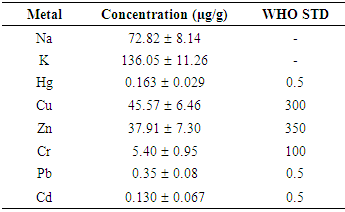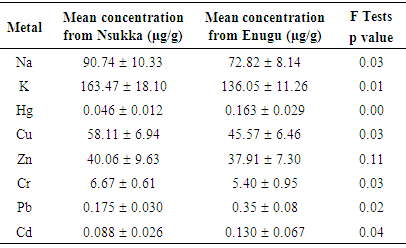-
Paper Information
- Previous Paper
- Paper Submission
-
Journal Information
- About This Journal
- Editorial Board
- Current Issue
- Archive
- Author Guidelines
- Contact Us
Food and Public Health
p-ISSN: 2162-9412 e-ISSN: 2162-8440
2018; 8(2): 42-46
doi:10.5923/j.fph.20180802.02

Comparative Assessment of the Heavy and Trace Metal Levels in Honey Produced within Nsukka and Enugu Metropolis
Ezeh Ernest1, Okeke Onyeka2, Ozuah A. C.3, Nwoye Benard4
1Chemical Engineering Department, Nnamdi Azikiwe University, Awka, Nigeria
2Plastic Production Unit, Scientific Equipment Development Institute, Enugu, Nigeria
3Integrated Science Department, Nwafor Orizu college of Education, Nsugbe, Nigeria
4Plastic Recycling Unit, Scientific Equipment Development Institute, Enugu, Nigeria
Correspondence to: Okeke Onyeka, Plastic Production Unit, Scientific Equipment Development Institute, Enugu, Nigeria.
| Email: |  |
Copyright © 2018 Scientific & Academic Publishing. All Rights Reserved.
This work is licensed under the Creative Commons Attribution International License (CC BY).
http://creativecommons.org/licenses/by/4.0/

The concentration of eight heavy and trace metals (Na, K, Hg, Cu, Zn, Cr, Cd and Pb) were determined in honeys produced within Nsukka and Enugu Metropolis using inductively coupled plasma mass spectrometer after micro-wave assisted acid digestion. The concentrations of the metals analyzed in the honeys from the studied environments were compared using ANOVA. The study detected the eight heavy and trace metals in the honey samples at concentrations within their respective WHO permissible limits. The mean concentration of the metals in the honey produced within Nsukka metropolis decreased in the following order: K > Na > Cu > Zn > Cr > Pb > Cd > Hg, with values of 163.47 ± 18.10, 90.74 ± 10.33, 58.11 ± 6.94, 40.06 ± 9.63, 6.67 ± 0.61, 0.175 ± 0.030, 0.088 ± 0.026 and 0.046 ± 0.012 µg/g respectively. Also, the mean concentrations of the metals in the honey produced within Enugu metropolis decreased in the following order: K > Na > Cu > Zn > Cr > Pb > Hg > Cd, with values of 136.05 ± 11.26, 72.82 ± 8.14, 45.57 ± 6.46, 37.11 ± 7.30, 5.40 ± 0.95, 0.35 ± 0.08, 0.163 ± 0.03 and 0.130 ± 0.067 µg/g respectively. With the exception of Zn, the concentrations of the other studied metals in the honeys produced from the two environments were statistically significant at p< 0.05.
Keywords: Honey, Trace elements, Heavy metals, Toxicity and Bioaccumulation
Cite this paper: Ezeh Ernest, Okeke Onyeka, Ozuah A. C., Nwoye Benard, Comparative Assessment of the Heavy and Trace Metal Levels in Honey Produced within Nsukka and Enugu Metropolis, Food and Public Health, Vol. 8 No. 2, 2018, pp. 42-46. doi: 10.5923/j.fph.20180802.02.
1. Introduction
- Honey is a sweet viscous food substance produced by bees and some related insects (Crane, 2000). Bees produce honey from the sugary secretions of plants (floral nectar) or other insects (aphid honey dew) through regurgitation, enzymatic activity and water evaporation. Honey is stored in wax structures called honey combs (Subramanian et al., 2007). The codex Alimentarius, (2001) defines honey as a natural sweet substance, produced by honey bees from the nectar of plants or from secretions of living parts of plants, which bees collect, transform by combining with specific substances of their own, deposit, dehydrate, store and leave in honey combs to ripen and mature. Honey produced by the honey bee is a natural super saturated sugar solution which has been seen as a high nutritive value food and is composed of a complex mixture of carbohydrates, minerals, vitamins, aromatic compounds, flavouring and enzymes (Haovam et al., 2016; Satiena et al., 2010). This natural product is so valuable as the only concentrated form of sugar available worldwide and is also used as a food preservative (Juszczak, et al., 2009). Honey contains a variety of macro and micro minerals that are the minor constituents of honey present in the range of 0.02 – 2.03%. Trace elements are mainly the ash contents of honey (Altun et al., 2017). The biochemical properties of honey and its qualities are related to honey maturity, climatic conditions, production methods, processing and storage conditions, as well as the nectar source of the honey (Guler et al., 2007; Oddo and Bogdanou, 2000). Metal concentrations in honey types depend largely on the elemental composition of flowers, with regard to their botanical and geographical origin (Rasheed and Soltan, 2004).The types of metals present in honey is related to the type of raw material i.e. the nectar, the pollen and the honey dew, which are collected by bees. The dispersion of metals on vegetables or fruits may directly end up in the food chain (Fakhimzadeh and Lodenus, 2000). One major way metals gets into food chain is through their spread over flowering plants. Metal polluted pollen may result in polluted honey (Jablonski et al., 2005). To produce half a kilogram of honey bees have to visit 5-7 millions of flowers and collect about 90,000 nectar loads of their colony (Altun et al., 2017). Jumping plant lice (Psyllids) produce considerable amounts of polluted honey dew that may be gathered by honey bees (Fakhimzadeh and Lodenus, 2000). Honey bees are permanently exposed to the influence of industrial and agricultural pollutants through the air, soil and water, hence researchers highlighted the possibility of honey as a biomarker (Oroian et al., 2014). Toxic trace elements or heavy metals have been reported to be found in higher concentrations in honeys found in close proximity to certain industrial areas (Bratu and Georgescu, 2005). Similarly, traffic-related pollution and chemical intensive agriculture, which contaminate the air, water and soil, can also contribute to the increasing levels of these elements in honey (Silici et al., 2013). Heavy metals are among the major contaminants of food supply and may be considered as the most problem to our environments, that can reduce both the productivity of plants and endanger the safety of plant products as foods and feeds (Zaidi et al., 2005; Zhelyazkou et al., 2006). Heavy metals in general are not biodegradable, have long biological half-lives and have the potential for accumulation in the different body organs leading to undesirable side effects (Radwan and Salama, 2006). Heavy metal contamination may occur due to factors including irrigation with contaminated water, the addition of fertilizers and metal-based pesticides, industrial emissions, transportation, harvesting process, storage and/or sale (Duran et al., 2007). The presence of metals in honey has the potential to threaten the health of humans as consumers. Lead, arsenic, cadmium and mercury are among the most abundant heavy metals and are particularly toxic. The excessive amount of these metals in food is associated with etiology of a number of diseases especially with cardiovascular, kidney, respiratory, nervous and as well as bone diseases (Mudgal et al., 2010).Metals such as potassium, sodium, calcium, zinc, iron and copper are essential for important biochemical and physiological functions and necessary for maintaining good health throughout life (Radwan and Salama, 2006).Risk assessment of trace elements was shown two levels of toxicity: firstly that associated with high intakes resulting in toxicity and secondly, that associate with low intakes which results in nutritional problems (Goldhaber, 2003). In recent years, the concentrations of different metals in honey have been determined in some countries such as China, Italy, France, Croatia and Poland e.t.c. (Aghamirlou et al., 2015). Higher Pb concentrations (up to 80.37mg/kg) were detected in honey samples collected from contaminated areas in Italy (Dambrosio and Marchesini, 2002).Nsukka and Enugu State particularly are major producers of honey in Nigeria because of favourable climatic conditions and thus its consumption and acceptance on account of its high originality necessitated this research to determine the level of its trace and heavy metals composition.
2. Methods
- Sample Collection: Beekeeping is widespread in Enugu State, Nigeria. A total of 40 samples of multi-floral honey were purchased from individual beekeepers in Enugu State: Nsukka Metropolis (n = 20) and Enugu metropolis (n = 20). All honey samples were purchased from the local beekeepers produced by traditional procedures and stored in clean and closed polyethylene flasks and stored at 20 – 21°C in a lightless place until analysis.Reagents and ChemicalsAll reagents used were of analytical grade. The stock solutions of Cu, Zn, Cr, Pb, Cd, K, Na and Hg (1000mg/l) were purchased from certified chemical dealers and the standard solutions of the metals were prepared by diluting them with deionized water in accordance with stipulated standard procedures (AOAC, 2006).All the plastic and glass ware were clean by soaking them in a 10% nitric and solution and rinsing them with distilled water prior to use.Analytical Determination The trace and heavy metal contents were analyzed by inductively coupled plasma mass spectrometer after micro-wave assisted acid digestion.1.0g of each sample was digested with 4.0ml of 65% (v/v) HNO3 and 0.5ml of 35% (v/v) H2O2 in PTFE vessels. A blank digestion was carried out in the same way. Digestion conditions for the microwave system applied were as follows: up to 120°C for 15min and then constant for 10min, up to 160°C in 20mins and constant for 15min, finally a cooling stage (30min) was carried out to 22°C and diluted to 50ml with deionized water. The solution was finally used for elemental analysis performed using a ICP –MS equipped with a concentric nebulizer, a quartz torch with quartz injection tube and cyclonic spray chamber. The concentrations of eight metals (Na, K, Zn, Cu, Hg, Pb, Cd and Cr) were determined in the honey samples.ICP – MS technique was used because of its ability to do multi-elemental analysis with excellent sensitivity, resulting in high precision and accuracy (Aghamirlou et al., 2015). A recovery study was carried out by spiking several samples with varied amount of standard solutions of the metals. The average recoveries obtained were, 89.17 ± 3.12, 94.55 ± 1.08, 92.71 ± 5.34, 97.87 ± 3.46, 85.93 ± 2.26, 90.04 ± 1.81, 95.03 ± 5.23 and 88.67 ± 2.50% for Na, K, Zn, Cu, Hg, Pb, Cd and Cr, respectively.Data Analysis: The statistical calculations and analysis were performed using SPSS version 18.0. ANOVA was used for the analysis of the data obtained and the level of significance was taken up as p < 0.05.
3. Results and Discussions
- Table 1 shows that the eight heavy and trace metals analyzed were present in the honey samples produced within Nsukka metropolis at varying concentrations. The mean concentrations of the metals in the heavy samples decreased in the following order: K > Na > Cu > Zn > Cr > Pb > Cd > Hg > with values of 163.47 ± 18.10, 90.74 ± 10.33, 58.11 ± 6.94, 40.06 ± 9.63, 6.67 ± 0.61, 0.175 ± 0.030, 0.088 ± 0.026 and 0.046 ± 0.012 µg/g respectively as shown in fig I. The analysis revealed that essential elements such as Na and K were of the highest concentration in the honey sample, followed by trace elements such as Cu, Zn, Cr, and the least were the heavy metals (Pb, Cd and Hg).
|
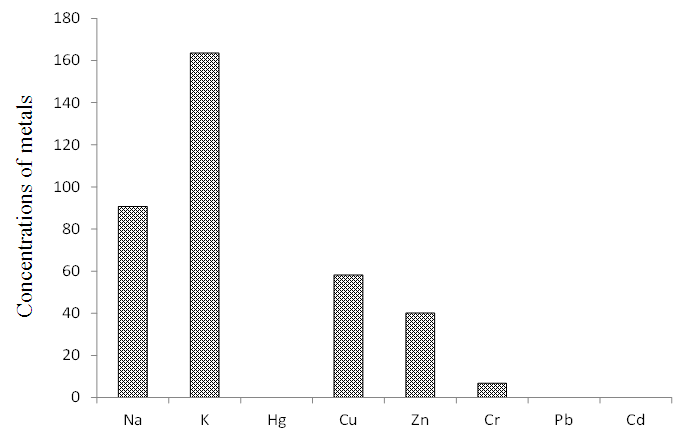 | Figure 1. Bar Chart representation of the mean concentration of heavy and trace metals in the honey produced within Nsukka metropolis (µg/g) |
|
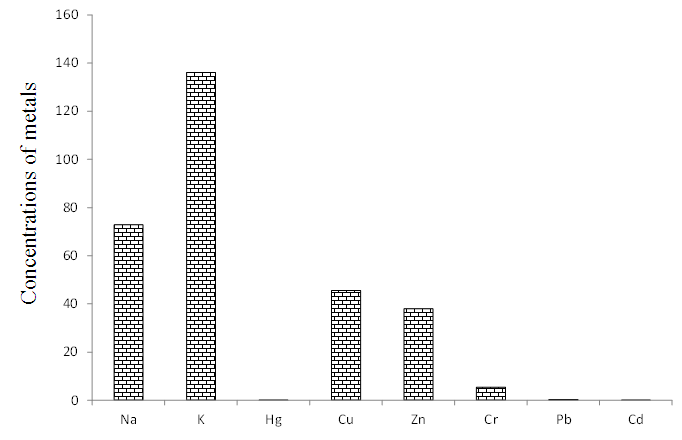 | Figure 2. Bar Chart representation of the mean concentration of heavy and trace metals in the honey produced within Enugu metropolis (µg/g) |
|
4. Conclusions
- The concentrations of the eight studied metals in the honey samples produced within Nsukka and Enugu metropolis were within their respective WHO recommended permissible levels.The findings shows that the honey samples were of very high nutritive value hence, contains higher levels of the essential and trace mineral elements needed for healthy living than the non-essential elements.Higher levels of anthropogenic activities which include, industrial and vehicular emissions, agricultural and industrial discharges which constitute environmental pollution could have contributed to the higher level of the studied heavy metals in the honey produced within Enugu metropolis than the honey samples produced within Nsukka metropolis.
 Abstract
Abstract Reference
Reference Full-Text PDF
Full-Text PDF Full-text HTML
Full-text HTML